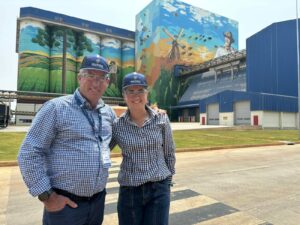Riordan Grain Services Managing Director Jim Riordan and daughter Ruby recently returned from a tour of grain growing areas and processing facilities in Brazil and Argentina. They were very impressed by the deep soils, crop production capacity, and the complexity of supply chain operations.
The RMI Analytics South American Insights Tour was attended by industry participants from around the world and included grain growers through to leading Brewsters. The tour focused on Malting Barley and brewery operations and included at visit to the world’s newest malt plant Maltaria Compos Gerais in Ponta Grossa with a processing capacity of 240kmt/year. They have developed a unique system that uses variable water temperatures to maximise the germination of a range of barley varieties with different moisture contents.
Brazil receives an average of 1,200mm/year of rain and mostly produces soybeans. However, they are experimenting with new barley varieties that can handle the wet conditions and fit into soyabean rotations. It is expected that the area planted to barley will expand over the coming years as they become more confident with the crop.
As the global discussion around sustainability and environmental management continues there is much to consider in these developing countries. For example, wood chips are currently used to fuel the burners to heat the water however as costs and pressure to reduce CO2 emissions increase, they may have to revise their systems.
The ability to make changes that would lower emissions in the transport system is also complicated. The network of roads and bridges would need considerable upgrading and building new rail infrastructure is unlikely due to the hills.
In Argentina Jim and Ruby were hosted by agribusiness advisors Alea. They visited the port city of Necochea in Buenos Aires Province, that exports 7 million tonnes of grain annually and toured production regions to see crops and meet with agronomists and farmers.
In contrast to Argentina, this region receives 650mm of rainfall, is flat with rich 30 to 60cm of topsoil over limestone. Here they are also experimenting with crops such as the Carinata oil seed for the Aviation fuels market along with barley, wheat, corn, and canola and Soybean rotations. This is a window of opportunity for Carinata oil, where nothing is usually grown and represents 5 million ha annually.
Overall, the trip was very interesting, and it was valuable to learn more about the agronomy of these crops and the potential for growth and expansion of the Malt Barley industry.

